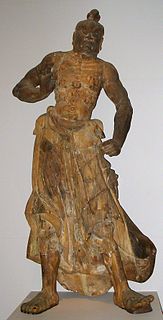 W
WThe Kamakura period is a period of Japanese history that marks the governance by the Kamakura shogunate, officially established in 1192 in Kamakura by the first shōgun, Minamoto no Yoritomo. The period is known for the emergence of the samurai, the warrior caste, and for the establishment of feudalism in Japan.
 W
WThe Kamakura shogunate was the feudal military government of Japan during the Kamakura period from 1185 to 1333.
 W
WAzuma Kagami is a Japanese historical chronicle.
 W
WHonederamura Shōen ruins is an archaeological site containing the ruins of a large-scale shōen manor from the Kamakura period, located in what is now part of the city of Ichinoseki, Iwate in the Tōhoku region of Japan. A portion of the site was designated a National Historic Site of Japan in 2005.
 W
WThe Irago Tōdai-ji Tile Kiln ruins is an archaeological site containing the remnants of a number of Anagama kilns, from which the roof tiles for the Kamakura period reconstruction of the temple of Tōdai-ji in Nara were made. The site is located in what is now part of the city of Tahara, Aichi Prefecture in the Tōkai region of Japan. It was designated a National Historic Site of Japan in 1967.
 W
WKamiichi Kurokawa Sites is a group of archaeological site in the town of Kamiichi, Toyama Prefecture in the Hokuriku region of Japan. It has been protected by the central government as a National Historic Site since 1981.
 W
WSugama Tōfukuji Stone Reliquary is a Kamakura period stone reliquary monument located within the grounds of the temple of Tōfuku-ji in the village of Tamakawa, Fukushima Prefecture, in the Tōhoku region of northern Japan. The stele was designated a National Historic Site of Japan in 1935 by the Japanese government.
 W
WTakanashi clan residence ruins is an archaeological site containing the ruins of the Kamakura to early Sengoku period fortified residence of the Takanashi clan, local warlords in northern Shinano Province during that period. The site is located in what is now part of the city of Nakano, Nagano in the Chūbu region of Japan. The site was designated a National Historic Site of Japan in 2007.